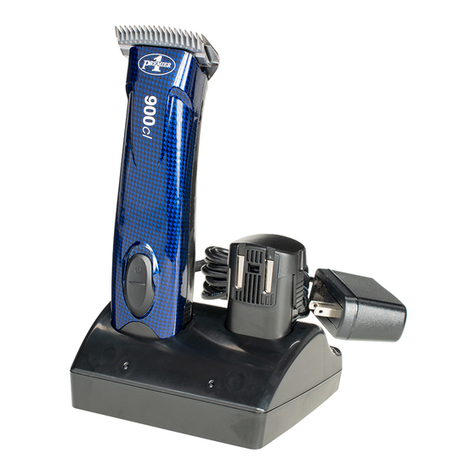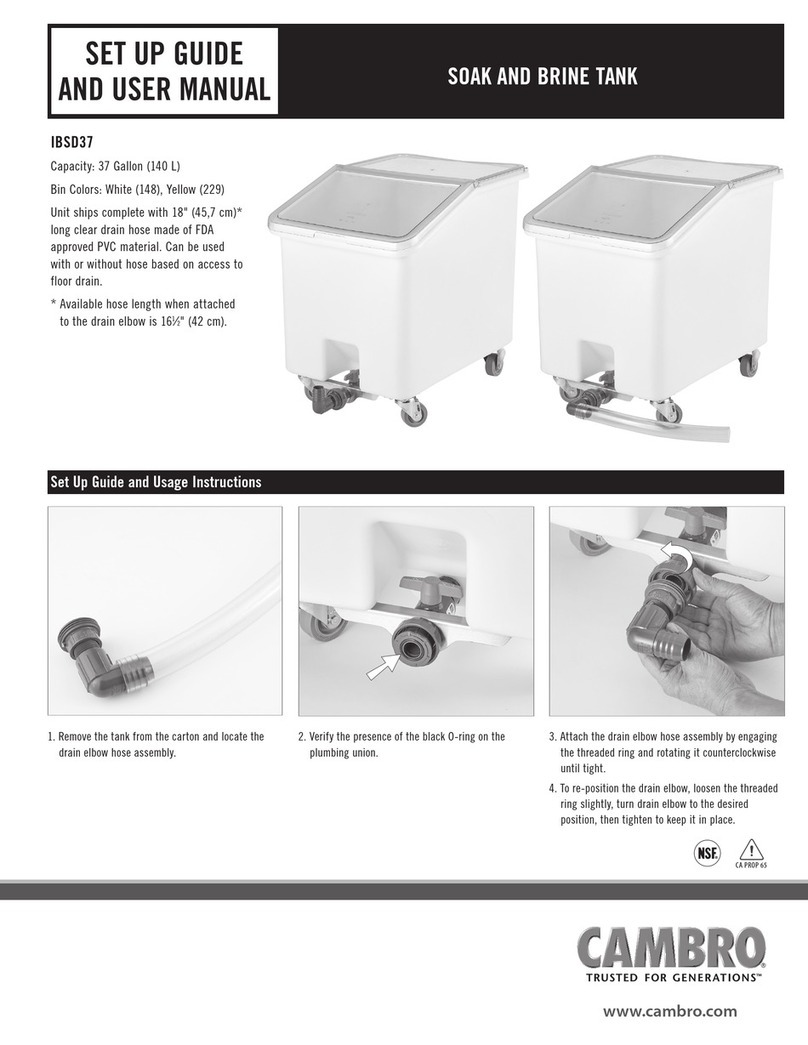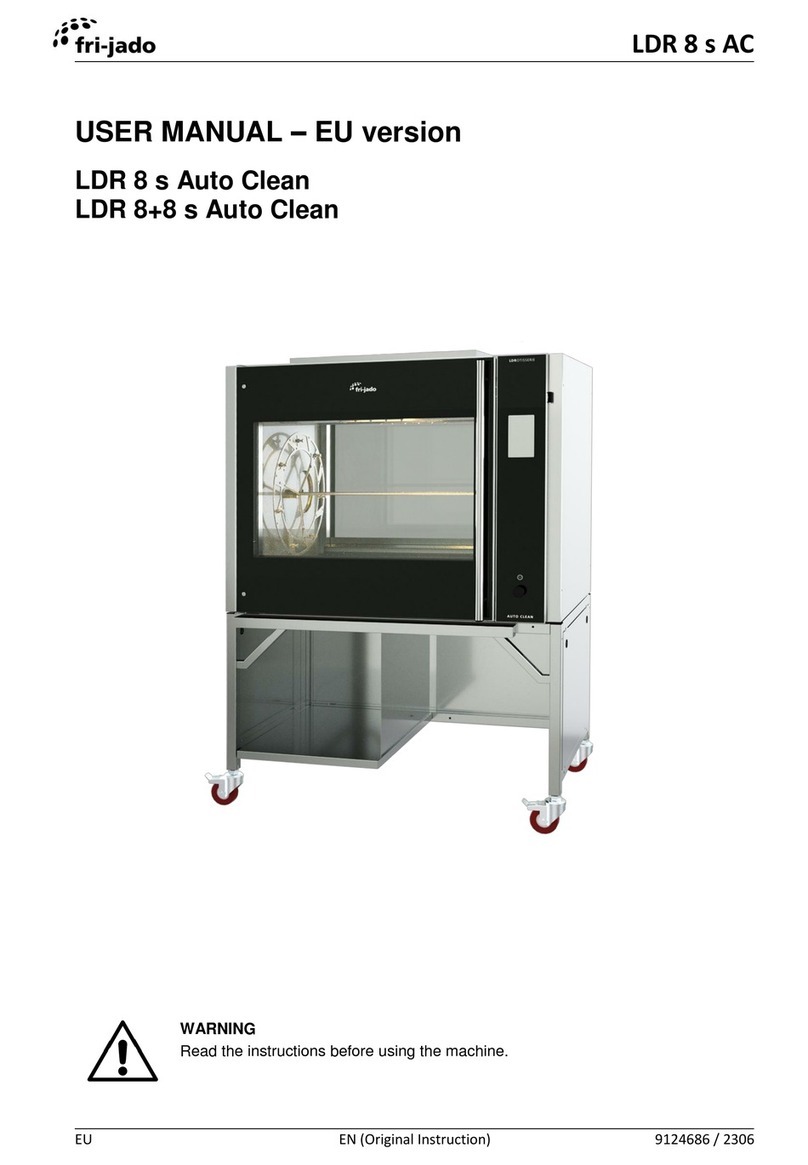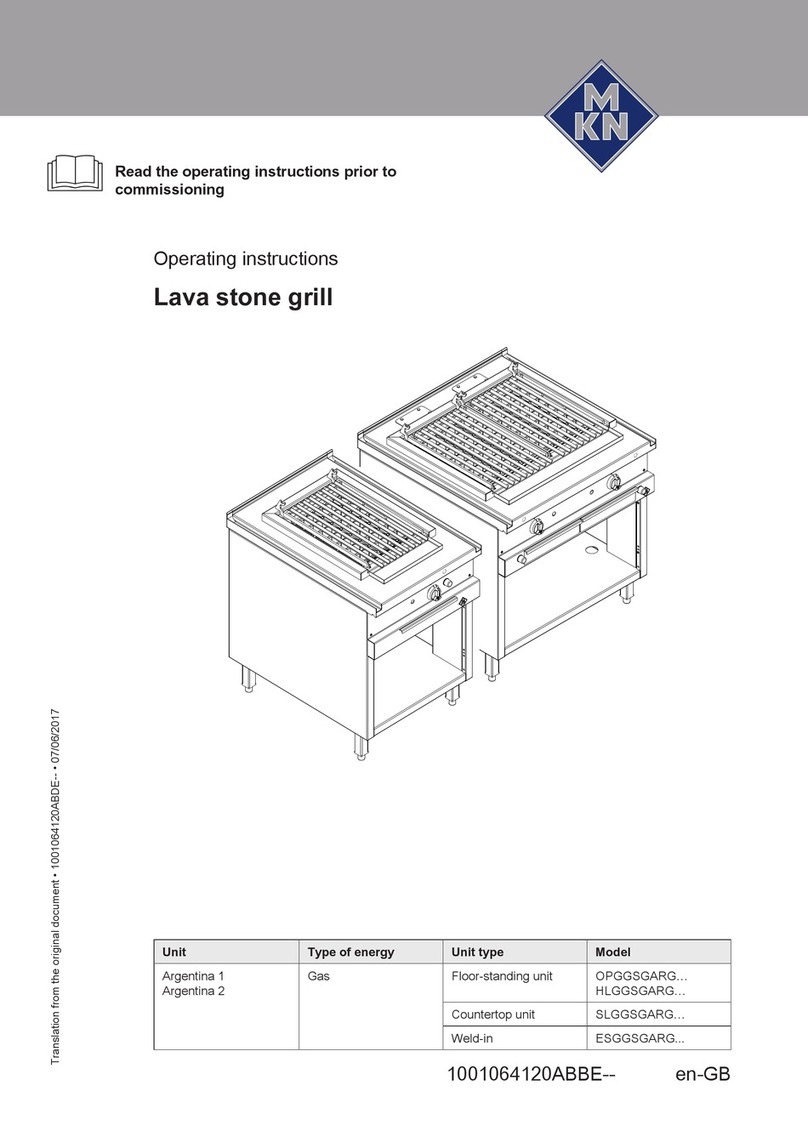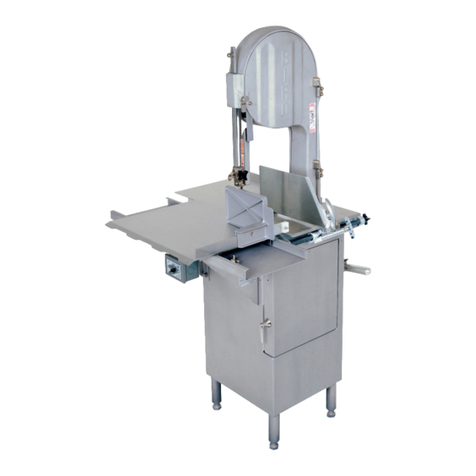
5
Elenco dei componenti:
N°04 profilati ad angolo - gambe (1-2-3-4)
N°02 traversini laterali lunghi (7-8)
N°01 ripiano per posizione bassa (9)
N°04 viti di livellamento M12 x 50
N°02 traversini frontali corti (5- 6 )
N°24 dadi M 8
N°24 viti M 8 x 15 di fissaggio
N°04 viti M 6 per fissaggio di sicurezza.
N°04 dadi M 6
Fissare provvisoriamente le gambe (1-2-3-4) al ripiano di lamiera
inserendo le viti (A) nel foro più in basso, come in figura; avvitare i
dadi senza serrarli completamente. Fissare i traversini corti (5 - 6)
alle gambe, inserendo le viti nei fori predisposti in alto. Fissare i
traversini laterali lunghi (7 - 8) alle gambe, mediante le apposite viti.
Avvitare alle estremità delle gambe, le quattro viti di livellamento (B)
da regolare secondo necessità per raggiungere il buon livellamento
anche su superfici irregolari. Procedere al completamento del
serraggio delle viti, adottando una squadra od una livella,
controllando sia la posizione perpendicolare delle gambe ed il buon
livellamento del ripiano. Serrare tutte le viti in modo energico.
L'apparecchio deve essere fissato in modo solido al proprio
supporto: avvitare a fondo le quattro viti di ancoraggio (C) disposte
ad ogni lato del supporto. Qualora non si utilizzi il supporto originale
da Noi realizzato, il corrispondente deve risultare robusto ed
irrovesciabile, nelle previste condizioni di utilizzo.
L'apparecchio di tipo termoelettrico è privo di parti in movimento e
produce solo calore all'interno del vano, rivestito con uno spesso
strato di speciali materiali isolanti refrattari al calore. L'operatore
deve fare particolare attenzione a non mettere a contatto delle
superfici calde, nessuna parte del corpo. All'esterno
dell'apparecchio, nei punti previsti, è posta la targa triangolare gialla
indicante le "Superfici Calde", la cui temperatura può produrre
ustioni se qualsiasi parte del corpo vi dovesse entrare in contatto.
Calzare sempre idonei guanti termoisolanti a cinque dita per non
ridurre la sensibilità di presa sugli oggetti da manipolare. Non
afferrare mai con le mani nude alcun elemento od oggetto che sia
stato posto all'interno del forno per riscaldarlo o per cuocerlo.
3 INSTALLAZIONE DEL FORNO.
Dislocare opportunamente il forno con l'eventuale supporto, nel
locale previsto, nel punto in cui sia agevole predisporre la presa di
alimentazione elettrica e gli apparecchi di protezione dell'operatore e
dell'apparecchiatura. Lasciare tutt'intorno lo spazio opportuno per la
ventilazione e la pulizia.
Il basamento del forno ed i piedi dell'incastellatura devono
appoggiare su una superficie solida, uniforme e ben livellata.
L'incastellatura non richiede alcun ancoraggio al suolo. Dopo il
piazzamento, livellare eventualmente l'apparecchio agendo sulle viti
M12, disponendo la livella sul forno, prima longitudinalmente poi
trasversalmente; raggiunto il livellamento, bloccare le viti.
4 INFORMAZIONI SULL'IMPIANTO
ELETTRICO.
L'equipaggiamento elettrico della macchina, progettato ed allestito
secondo le nome EN - CEI già citate, definito di Classe I, è
configurato nel modo seguente:
- termostato di regolazione e controllo della temperatura della cella
di cottura;
- resistenze di riscaldamento di tipo corazzato con tubo esterno
acciaio inox aisi 321 ricotto, con zona neutra da 100 mm per la
riduzione della conduzione del calore ai supporti. Elemento resistivo
di riscaldamento, in nikelcromo 80 // 20 - Isolamento ceramico in
MgO;
- morsettiere di collegamento e derivazione, installate all'interno del
vano contenente le apparecchiature di comando e controllo;
- lampade spia del funzionamento del termostato di regolazione;
- cablaggio di collegamento generale dei dispositivi del circuito
dell'apparecchio, realizzato con cavi idonei alle gravose condizioni di
impiego ed adeguato limite di sovratensione.
Sul fianco dx del forno, in corrispondenza di una vite di fissaggio, è
stata applicata una targhetta riportante il simbolo di “attenzione ten-
tensione pericolosa”. Ha lo scopo di avvisare l’utenza che la rimozio-
ne del predetto fianco, espone al rischio di folgorazione per la pre-
senza di impianto sotto tensione. Per qualsiasi intervento, rivolgersi
al servizio assistenza o a personale specializzato.
5 COLLEGAMENTO ALLA RETE ELETTRICA.
Il collegamento alla rete elettrica e la messa in servizio
dell'apparecchio deve essere eseguito da un'installatore
specializzato ed esperto, seguendo le disposizioni tecniche e
normative del paese di installazione.
List of the components:
4 square sections - legs (1, 2, 3, 4)
2 long lateral sections (7, 8)
1 shelf for low position (9)
4 leveling screws, M12 x 50
2 short front sections (5, 6 )
24 nuts, M 8
24 fastening screws, M 8 x 15
4 safety fastening screws, M 6
4 nuts, M 6
Temporarily attach the legs (1, 2, 3, 4) to the sheet-metal shelf by
placing the screws (A) in the lowest hole, as shown in the figure, and
then screw on the nuts without tightening them completely. Attach
the short sections (5, 6) to the legs by placing the screws in the
upper holes. Attach the long lateral sections (7, 8) to the legs by
means of the proper screws. At the ends of the legs adjust the four
leveling screws (B) so as to level the unit well even on uneven
surfaces. Proceed to finish tightening the screws while using a
square or a level to check that the legs are in a perpendicular
position and that the shelf is level. Tighten all the screws very well.
The unit must be solidly attached to its support: completely tighten
the four anchor screws (C) located on each side of the support. If
you will not be using the original support manufactured by us, the
support you do use must be sturdy and impossible to overturn under
the conditions in which the unit will be used.
The thermoelectric unit does not have any moving parts and
produces only heat inside the oven compartment which is lined with
a thick layer of special insulating refractory materials. The operator
must be especially careful not to allow any part of his body to come
into contact with the hot surfaces. There is a yellow triangular plate
attached to the unit’s exterior which indicates the "Hot Surfaces" that
reach a temperature that could cause burns if any part of the body
comes into contact with them. Always wear suitable heat-insulating
five-fingered gloves so as not to reduce your grip on objects when
you are handling them. Do not use your bare hands to grasp any
part or object that was placed inside the oven to be heated or
cooked.
3 INSTALLING THE OVEN.
In the room where you desire to install the oven, move it and its
support (if you are using the support) to a position in which it can
easily be plugged into the power supply and in which it is easy to
install the operator’s protection equipment and other equipment.
Leave enough space around the unit for ventilation and for cleaning.
The oven’s base and the frame’s feet must rest on a solid, flat, and
very level surface. The frame does not require anchoring to the
ground. After the unit has been put into place, level it by means of
the M 12 screws. Place the level on the oven; when the oven is
leveled, first lengthwise and then crosswise, tighten the screws.
4 INFORMATION ON THE ELECTRICAL SYSTEM.
The unit’s electrical system was designed and built according to the
EN and CEI standards listed previously in this manual. It is classified
as a Class I electrical system and has the following configuration:
- Thermostat for adjusting and controlling the temperature of the
cooking compartment.
- Armored heating elements with an outer tube made of annealed
AISI 321 stainless steel, with a 100-mm neutral zone for reducing
heat conduction to the supports. Resistive heating element made of
80 // 20 nickelchromium alloy - ceramic insulation made of MgO.
- Connection and shunt terminal boards installed inside the
compartment that contains the control equipment.
- Indicator lights for indicating the functioning of the adjustment
thermostat.
- General connection wiring for the components of the unit’s circuit,
using power cables that are suitable for the difficult conditions of use
and with an adequate overvoltage limit.
On the right side of the oven, close to a fastening screw, there is a
panel with the symbol “caution: dangerous tension”. Its purpose is to
warn the users that the removal of the mentioned side exposes to a
risk of electrocution because of installation under tension. For any
intervention, please apply to the customer service or to qualified
technician.
5 POWER SUPPLY CONNECTION.
The connection to the electric power mains and preparing the oven
for use must be performed by a specialized expert installer in
accordance with the standards and technical regulations of the
country in which it is to be installed. Place a length of power cable
near the unit so as to permit the installed power cable to reach the
power socket. Do not use extension cables to make this connection.
Install a box to hold the installation equipment.




